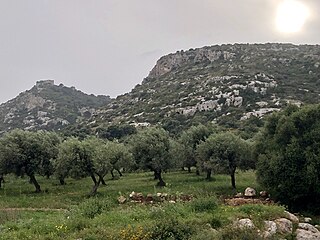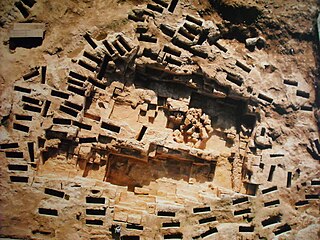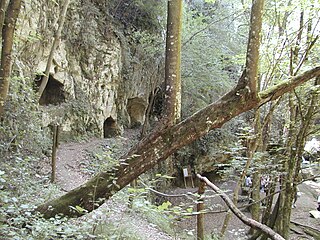
A tumulus is a mound of earth and stones raised over a grave or graves. Tumuli are also known as barrows, burial mounds or kurgans, and may be found throughout much of the world. A cairn, which is a mound of stones built for various purposes, may also originally have been a tumulus.

The Golasecca culture was a Late Bronze Age/Early Iron Age culture in northern Italy, whose type-site was excavated at Golasecca in the province of Varese, Lombardy, where, in the area of Monsorino at the beginning of the 19th century, Abbot Giovanni Battista Giani made the first findings of about fifty graves with pottery and metal objects.

A necropolis is a large, designed cemetery with elaborate tomb monuments. The name stems from the Ancient Greek νεκρόπολις nekropolis.

The Gaudo Culture is an Eneolithic culture from Southern Italy, primarily in the region of Campania, active at the end of the 4th millennium BC, whose typesite necropolis is located near Paestum, not far from the mouth of the river Sele. Its name comes from the Spina-Gaudo necropolis.

The Monterozzi necropolis is an Etruscan necropolis on a hill east of Tarquinia in Lazio, Italy. The necropolis has about 6,000 graves, the oldest of which dates to the 7th century BC. About 200 of the tomb chambers are decorated with frescos.
Part of series of articles upon Archaeology of Kosovo

The Necropolis of Cassibile is a large archaeological site in the Province of Syracuse, near the towns of Avola and Cassibile. The site contains a very large graves system situated inside several ravines; the largest of them is called "Cavagrande". About 2,000 graves carved out of the rock have been found; they are dated from the 11th to the 9th century BC. This necropolis gives the name to a precise period of the Sicels' civilization.

The necropolis of Tuvixeddu is a Punic necropolis, the largest in the Mediterranean. It is located in a hill inside the city of Cagliari, Sardinia called Tuvixeddu.
Enrico Santangelo is an Italian author and art historian.

Cava del Rivettazzo is a Sicel necropolis located about 4 km north of Solarino on the SP 28 to Sortino.

The Castle of Fossa is a Middle Ages castle in Fossa, province of L'Aquila, Abruzzo, southern Italy.

Castello di Ocre is a medieval castle in Ocre, Province of L'Aquila, Abruzzo, southern Italy.

The Castle of Sant'Eusanio Forconese is a medieval castle in Sant'Eusanio Forconese, Province of L'Aquila, Abruzzo, southern Italy.

Etruscan architecture was created between about 900 BC and 27 BC, when the expanding civilization of ancient Rome finally absorbed Etruscan civilization. The Etruscans were considerable builders in stone, wood and other materials of temples, houses, tombs and city walls, as well as bridges and roads. The only structures remaining in quantity in anything like their original condition are tombs and walls, but through archaeology and other sources we have a good deal of information on what once existed.

Eremo di San Bartolomeo in Legio is an hermitage located in Roccamorice, Province of Pescara, in the Abruzzo region of Italy.

Tombe rupestri di San Liberatore is a burial place located in Serramonacesca, Province of Pescara.
Museo Archeologico Nazionale di Campli is an archaeology museum in Campli, Abruzzo.

The necropolis of Santu Pedru is an archaeological site of the municipality of Alghero, Sardinia.
There are some Macedonian tombs and the necropolises of Pydna around ancient Pydna and beside the ancient road from Methone in the north to Dion in the south. The oldest tombs are from the Bronze Age; the youngest are from the early Christian period. Smaller tumuli have eroded over time and are no longer visible. Most excavations have had to be carried out to save the sites. The finds in both areas show a shrinking population during the second Greek colonization.
The Pigi Athinas is an archaeological site at the eastern foot of Mount Olympus, near the village of Platamonas.



















